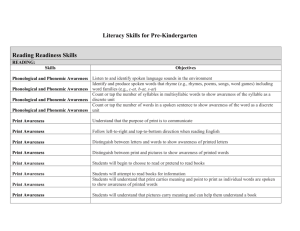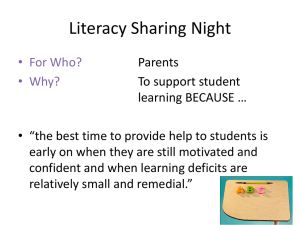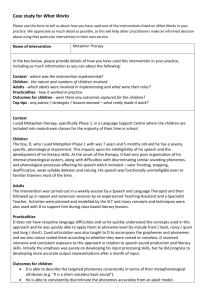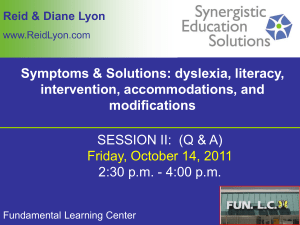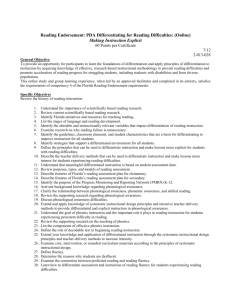- Florida Center for Reading Research
advertisement
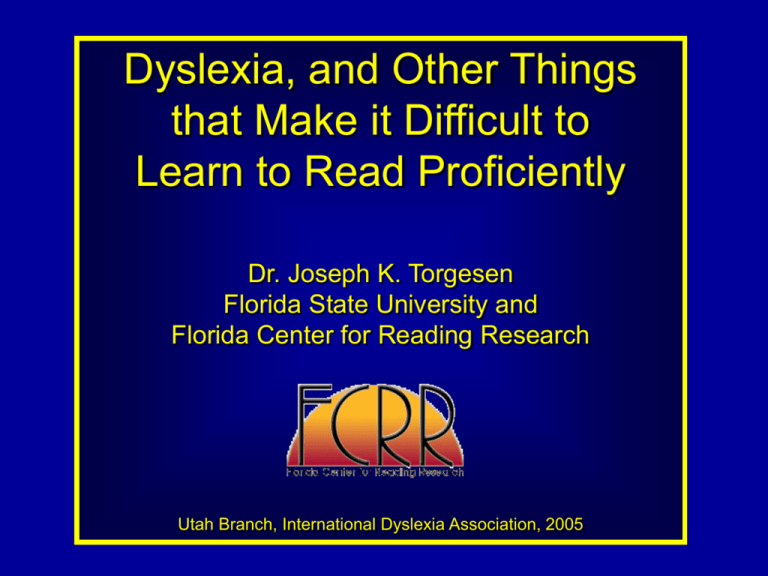
Dyslexia, and Other Things that Make it Difficult to Learn to Read Proficiently Dr. Joseph K. Torgesen Florida State University and Florida Center for Reading Research Utah Branch, International Dyslexia Association, 2005 First Reader By Billy Collins I can see them standing politely on the wide pages that I was still learning to turn, Jane in a blue jumper, Dick with his crayon-brown hair, playing with a ball or exploring the cosmos of the backyard, unaware they are the first characters, the boy and girl who begin fiction. Beyond the simple illustrations of their neighborhood, the other protagonists were waiting in a huddle: frightening Heathcliff, frightened Pip, Nick Adams carrying a fishing rod, Emma Bovary riding into Rouen. But I would read about the perfect boy and his sister even before I would read about Adam and Eve, garden and gate, and before I heard the name Gutenberg, the type of their simple talk was moving into my focusing eyes. It was always Saturday and he and she were always pointing at something and shouting, “Look!” pointing at the dog, the bicycle, or at their father as he pushed a hand mower over the lawn, waving at aproned mother framed in the kitchen doorway, pointing toward the sky, pointing at each other. They wanted us to look but we had looked already and seen the shaded lawn, the wagon, the postman. We had seen the dog, walked, watered and fed the animal, and now it was time to discover the infinite, clicking permutations of the alphabet’s small and capital letters. Alphabetical ourselves in the rows of classroom desks, we were forgetting how to look, learning how to read. “Current difficulties in reading largely originate from rising demands for literacy, not from declining absolute levels of literacy” Increasing demands for higher levels of literacy in the workforce require that we do better than we have ever done before in teaching all children to read well. The influence of the NAEP results Far too many students across the nation cannot meet grade level standards in reading in 4th and 8th grades Nationally Utah Poor 4th – 37% 4th – 34% 49% 8th – 26% 8th – 24% 48% When we say that our goal is to help all students read “at grade level or above” what do we really mean? We want students to be able to read grade level text with a reasonable level of understanding We usually also mean we want them to be able to do this fluently, so that reading the text doesn’t take an inordinate amount of time. And we would like them to find pleasure in reading, which also means we would like them to be able to read a book like we read books, without having to struggle with the words, and be able to focus on the meaning What skills, knowledge, and attitudes are required for good reading comprehension? What we know about the factors that affect reading comprehension Proficient comprehension of text is influenced by: Accurate and fluent word reading skills Oral language skills (vocabulary, linguistic comprehension) Extent of conceptual and factual knowledge Knowledge and skill in use of cognitive strategies to improve comprehension or repair it when it breaks down. Reasoning and inferential skills Motivation to understand and interest in task and materials In other words, student’s reading comprehension depends on: How well they read the words on the page How much knowledge they have, and how well they think How motivated they are to do “the work” of comprehension The Many Strands that are Woven into Skilled Reading (Scarborough, 2001) LANGUAGE COMPREHENSION BACKGROUND KNOWLEDGE VOCABULARY KNOWLEDGE LANGUAGE STRUCTURES VERBAL REASONING Skilled Readingfluent coordination of word reading and SKILLED READING: fluent execution and comprehension coordination of word recognition and text processes comprehension. LITERACY KNOWLEDGE WORD RECOGNITION PHON. AWARENESS DECODING (and SPELLING) SIGHT RECOGNITION Reading is a multifaceted skill, gradually acquired over years of instruction and practice. Three potential stumbling blocks to becoming a good reader (NRC Report, 1998) 1. Difficulty learning to read words accurately and fluently 2. Insufficient vocabulary, general knowledge, and reasoning skills to support comprehension of written language 3. Absence or loss of initial motivation to read, or failure to develop a mature appreciation of the rewards of reading. The Many Strands that are Woven into Skilled Reading (Scarborough, 2001) LANGUAGE COMPREHENSION BACKGROUND KNOWLEDGE VOCABULARY KNOWLEDGE LANGUAGE STRUCTURES VERBAL REASONING Skilled Readingfluent coordination of word reading and SKILLED READING: fluent execution and comprehension coordination of word recognition and text processes comprehension. LITERACY KNOWLEDGE WORD RECOGNITION PHON. AWARENESS DECODING (and SPELLING) SIGHT RECOGNITION Reading is a multifaceted skill, gradually acquired over years of instruction and practice. What is the most critical problem for students with specific learning disabilities in reading, or dyslexia? Three potential stumbling blocks to becoming a good reader (NRC Report, 1998) 1. Difficulty learning to read words accurately and fluently 2. Insufficient vocabulary, general knowledge, and reasoning skills to support comprehension of written language 3. Absence or loss of initial motivation to read, or failure to develop a mature appreciation of the rewards of reading. Extreme difficulties mastering the use of “phonics” skills as an aid to early, independent reading • difficulties with the skills of blending and analyzing the sounds in words (phonemic awareness). • difficulties learning letter-sound correspondences Slow development of “sight vocabulary” arising from: •limited exposure to text •lack of strategies to reliably identify words in text Alexis…. The nature of the underlying difficulty for most children who have specific reading disabilities or dyslexia Weaknesses in the phonological area of language ability inherent, or intrinsic, disability Expressed primarily by delays in the development of phonemic awareness and phonics skills What is phonemic awareness? • Phonemic awareness is the ability to identify, think about, or manipulate the individual sounds in words Words are composed of strings of phonemes. A phoneme is the smallest unit of sound in a word that makes a differences to its identity big dig bog bin Words are composed of strings of phonemes. A phoneme is the smallest unit of sound in a word that makes a differences to its identity big dig bog bin Why is it so difficult for some children to acquire sufficient phonemic awareness to enable good growth in word reading ability? Discovery work with Phonemes Why speech is easy and reading is hard Every phoneme is made with a unique articulatory gesture Phonemes differ in place and manner of articulation, and in voicing Now, for the thing that makes reading hard for some students…. fat---friend beet ball Discovery work with Phonemes Why speech is easy and reading is hard Every phoneme is made with a unique articulatory gesture Phonemes differ in place and manner of articulation, and in voicing The phonemes in words are co-articulated. Their pronunciation overlaps, so that what we hear is a single, seamless beat of sound. As Frith (1978) explained, “although speech can be made visible on a spectrograph, the picture reveals no natural segments that might correspond to single letters.” Phonemes are abstracted from the speech stream Phonemes have many allophonic variations that differ in acoustic properties, but which must be recognized as a single phoneme before the alphabet makes sense These children we have referred to as “reading disabled” or “dyslexic” A new science based definition -“Dyslexia is a specific learning disability that is neurobiological in origin. It is characterized by difficulties with accurate and/or fluent word recognition and by poor spelling and decoding abilities. These difficulties typically result from a deficit in the phonological component of language that is often unexpected in relation to other cognitive abilities and the provision of effective classroom instruction.” (Lyon & Shaywitz, 2003) These children we have referred to as “reading disabled” or “dyslexic” A new science based definition -“Dyslexia is a specific learning disability that is neurobiological in origin. It is characterized by difficulties with accurate and/or fluent word recognition and by poor spelling and decoding abilities. These difficulties typically result from a deficit in the phonological component of language that is often unexpected in relation to other cognitive abilities and the provision of effective classroom instruction.” (Lyon & Shaywitz, 2003) These children we have referred to as “reading disabled” or “dyslexic” A new science based definition -Secondary consequences may include problems in reading comprehension and reduced reading experience that can impede growth of vocabulary and background knowledge.” Lyon, G.R. & Shaywitz, S.E. (2003). A definition of dyslexia. Annals of Dyslexia, 53, 1-14 Recent Functional Neuroimaging findings on Adults Auditory Cortex Visual Cortex Temple, 2001, CONB What have we discovered about the effects of remedial and preventive instruction on brain functioning? Magnetic Source Imaging • Detects small biomagnetic brain signals • Provides real-time information about which brain areas are active and when during task performance Neural Response to Intervention Does the pattern of brain activation change in response to intervention? 8 children with severe dyslexia (7 to 17) 8 week intense phonologically- based intervention (2 hours a day= up to 80 hours of instruction) Very large improvements in reading ability Simos et al., Neurology, 2002 Strong activation pattern Weak activation pattern Decreased activity in right hemisphere Increased activity in left hemisphere Decreased activity in right hemisphere Increased activity in left hemisphere Early Development of Reading Skills: A Cognitive Neuroscience Approach Jack M. Fletcher – PI Students were identified as at risk for reading difficulties in kindergarten Received one year of intervention in first grade Kindergarten S#1 Weak activation S#31 Strong activation At Risk Reader Left Kindergarten Before Intervention First Grade After Intervention Right Important fact about talent in the phonological language domain: It is like most other talents in that it is distributed normally in the population “Phonological talent” is normally distributed in the population Children can be strong in this talent-like my grandson Andrew Percentile Ranks 50th 16th 84th 2nd 70 98th 85 100 Standard Scores 115 130 “Phonological ability” is normally distributed in the population Children can be moderately weak in this talent-like David Percentile Ranks 50th 16th 84th 2nd 70 98th 85 100 Standard Scores 115 130 David Each of these kinds of weakness is normally distributed in the population Serious difficulties-probably require special interventions and a lot of extra support-like Alexis Percentile Ranks 50th 16th 84th 2nd 70 98th 85 100 Standard Scores 115 130 Special work to develop phonemic awareness Learning letter-sound relationships Blending sounds into words Remember- “Phonics does not have to be boring” Another important fact about talent in the phonological language domain: It is only weakly correlated with broad verbal ability or general intelligence Phonological Language Ability is not highly Correlated with General Verbal Ability as measured by IQ tests High Low High Dyslexic Low Verbal Intelligence Phonological Language Ability is not highly Correlated with General Verbal Ability as measured by IQ tests High Low High Dyslexic Low Verbal Intelligence Before we understood what actually caused dyslexia, we defined it by exclusion: Reading problems in the absence of low verbal intelligence, cultural differences, opportunities to learn, visual or auditory problems, or emotional disturbance However, now that we know the fundamental cause of most dyslexia—we define it by the presence of weakness in the phonological domain of language Children with weaknesses in the phonological domain-regardless of their level of performance on a test of general IQ, struggle in early reading for the same reason—lack of phonological skill Regardless of level of general IQ, these children require the same type of explicit and systematic support for the development of early phonemic reading skills in order to make normal progress in learning to read One more important fact about talent in the phonological language domain: Children’s ability in this area when they come to school is influenced both by biologically based talent, and by opportunities to learn from their preschool environment Children come to school very different from one another in the experience they have had that prepares them for learning to read Development of Phonological Sensitivity Cross-sectional study comparing the performance of 250 children from higher income families to 170 children from lower income families. Children were between two- and five-years of age. SES Differences in Phonological Sensitivity Children completed tests of phonological sensitivity and awareness that assessed their ability to identify and blend words, syllables, onset-rimes, or phonemes. To summarize: Children can come to school weak in phonological ability either because of their biology or their language experience Regardless of whether they also have broader weaknesses in verbal ability, both types of children need similar intensive early reading support in order to prevent reading failure From a recent multi-disciplinary scientific review of the research: “From all these different perspectives, two inescapable conclusions emerge. The first is that mastering the alphabetic principle is essential to becoming proficient in the skill of reading….” and the second is that instructional techniques (namely phonics) that teach this principle directly are more effective than those that do not.” Raynor, K., Foorman, B.R., Perfetti, C.A., Pesetsky, D., & Seidenberg, M.S. 2001. How psychological science informs the teaching of reading. Psychological Science in the Public Interest, 2: 31-73. Three potential stumbling blocks to becoming a good reader (NRC Report, 1998) 1. Difficulty learning to read words accurately and fluently 2. Insufficient vocabulary, general knowledge, and reasoning skills to support comprehension of written language 3. Absence or loss of initial motivation to read, or failure to develop a mature appreciation of the rewards of reading. The Effects of Weaknesses in Oral Language on Reading Growth (Hirsch, 1996) 16 High Oral Language in Kindergarten 15 14 5.2 years difference Reading Age Level 13 12 11 Low Oral Language in Kindergarten 10 9 8 7 6 5 5 6 7 8 9 10 11 12 13 Chronological Age 14 15 16 Percentile on test of Oral Vocab. 60 Percentile scores on Peabody of 29,000 students in RF schools 50 Median Percentile 40 37 30 32 20 32 34 Bottom 20% 12 8 10 Kinder. 1st 9 12 2nd 3rd Bringing Words to Life Isabel Beck M. McKeown L. Kucan Guilford Press Big ideas from “Bringing Words to Life” First-grade children from higher SES groups know about twice as many words as lower SES children Poor children, who enter school with vocabulary deficiencies have a particularly difficult time learning words from “context” Research has discovered much more powerful ways of teaching vocabulary than are typically used in classrooms – generalization to reading comprehension A “robust” approach to vocabulary instruction involves directly explaining the meanings of words along with thought-provoking, playful, interactive follow-up. Four Critical Elements for More Robust Vocabulary Instruction Select the right words to teach – Tier 2 words absurd fortunate ridiculous Develop child-friendly definitions for these words Engage children in interesting, challenging, playful activities in which they learn to access the meanings of words in multiple contexts Find a way to devote more time during the day to vocabulary instruction And we haven’t yet mentioned motivation… Detailed studies of effective teachers document that they are powerful motivators: “Basically, we found that engaging primary-grades teachers do something every minute of every hour of every school day to motivate their students, using every conceivable motivational mechanism to do so---from praising specific accomplishments to reminding students how well they perform when they try to encouraging constructive possible selves (e.g., imagining themselves going to college). Pressley, 2004 Lets talk about motivation a moment… Detailed studies of effective teachers document that they are powerful motivators: “Less engaging teachers actually do much to undermine student motivation, including, for example, establishing a negative tone in the class, placing great emphasis on extrinsic rewards, calling attention to weak performances by students, providing ineffective or unclear feedback, and fostering competition among students. Engaging teachers never teach in ways that undermine students’ motivation. Pressley, 2004 A final concluding thought…. There is no question but that “leaving no child behind in reading” is going to be a significant challenge… It will involve professional development for teachers, school reorganization, careful assessments, and a relentless focus on the individual needs of every child… But, its not the most difficult thing we could be faced with… Consider this task for example… www.fcrr.org Science of reading
